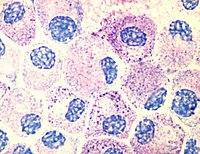
Human filariasis—contributions of the Litomosoides sigmodontis and Acanthocheilonema viteae animal model
Sign Up to like & getrecommendations! Published in 2021 at "Parasitology Research"
DOI: 10.1007/s00436-020-07026-2
Abstract: Filariae are vector-borne parasitic nematodes that are endemic worldwide, in tropical and subtropical regions. Important human filariae spp. include Onchocerca volvulus, Wuchereria bancrofti and Brugia spp., and Loa loa and Mansonella spp. causing onchocerciasis (river… read more here.
Keywords: filariasis; lymphatic filariasis; acanthocheilonema viteae; sigmodontis acanthocheilonema ... See more keywords

Limited role of mast cells during infection with the parasitic nematode Litomosoides sigmodontis
Sign Up to like & getrecommendations! Published in 2020 at "PLoS Neglected Tropical Diseases"
DOI: 10.1371/journal.pntd.0008534
Abstract: Mast cells are innate effector cells that due to their localization in the tissue form the first line of defense against parasites. We have previously shown that specifically mucosal mast cells were essential for the… read more here.
Keywords: nematode litomosoides; mast cells; mast; infection ... See more keywords

Unbalanced Arginine pathway and altered maturation of pleural macrophages in Th2-deficient mice during Litomosoides sigmodontis filarial infection
Sign Up to like & getrecommendations! Published in 2022 at "Frontiers in Immunology"
DOI: 10.3389/fimmu.2022.866373
Abstract: Filarial parasites are tissue dwelling worms transmitted by hematophagous vectors. Understanding the mechanisms regulating microfilariae (the parasite offspring) development is a prerequisite for controlling transmission in filarial infections. Th2 immune responses are key for building… read more here.
Keywords: th2 deficient; litomosoides sigmodontis; pleural macrophages; pathology ... See more keywords

Potential of Nucleic Acid Receptor Ligands to Improve Vaccination Efficacy against the Filarial Nematode Litomosoides sigmodontis
Sign Up to like & getrecommendations! Published in 2023 at "Vaccines"
DOI: 10.3390/vaccines11050966
Abstract: More than two-hundred-million people are infected with filariae worldwide. However, there is no vaccine available that confers long-lasting protection against filarial infections. Previous studies indicated that vaccination with irradiated infective L3 larvae reduces the worm… read more here.
Keywords: vaccination; irradiated larvae; litomosoides sigmodontis; acid receptor ... See more keywords